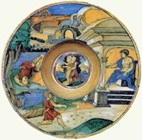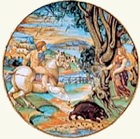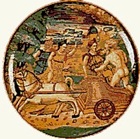

Giorgio di Pietro Andreoli (Mastro Giorgio) was born in Lombardy but moved to Gubbio, where Duke Guidobaldo da Montefeltro awarded him citizenship in 1498. He acquired premises near the Duomo in 1499. Pope Leo X renewed his citizenship in 1519, in a brief in which he was described as "an excellent master in the art of maiolica... whose work brings honor to the city, lord and people of Gubbio in all the nations to which the pottery of his workshop is exported, as well as great income in customs dues."
Mastro Giorgio perfected the technique of lusterware, in which red and gold metallic luster is applied to the surface of pottery in a third firing. The technique was known in the Islamic work, but Mastro Giorgio was among the first exponents of it in Italy and it was at the heart of his success. He was frequently commissioned to embellish the output of other workshops.
The last known signed work by Mastro Giorgio dates to 1541 and he seems to have retired in 1546, some seven years before his death.
Works in the Museo della Ceramica

-
✴a plate (1527) signed by Master Giorgio that depicts the Fall of Phaeton, which was bought at great expense at auction in Zurich in 1991; and
-
✴a plate (1528) attributed to Francesco Xanto Avelli and finished by Master Giorgio that depicts the fable of Circe, Picus and Canens, which was purchased in 1997.

They are now in the Museo della Ceramica, which is part of the Museo Civico.
Works in the Museo della Maiolica a Lustro
-
✴a plate (1537) signed by Mastro Giorgio that depicts the rape of Persephone (illustrated here); and
-
✴St Antony of Padua [details?].
St Antony Abbot (16th century)
This terracotta statue in San Domenico (on the 7th altar on the left) is traditionally attributed to Mastro Giorgio.
Return to Art in: Gubbio.


